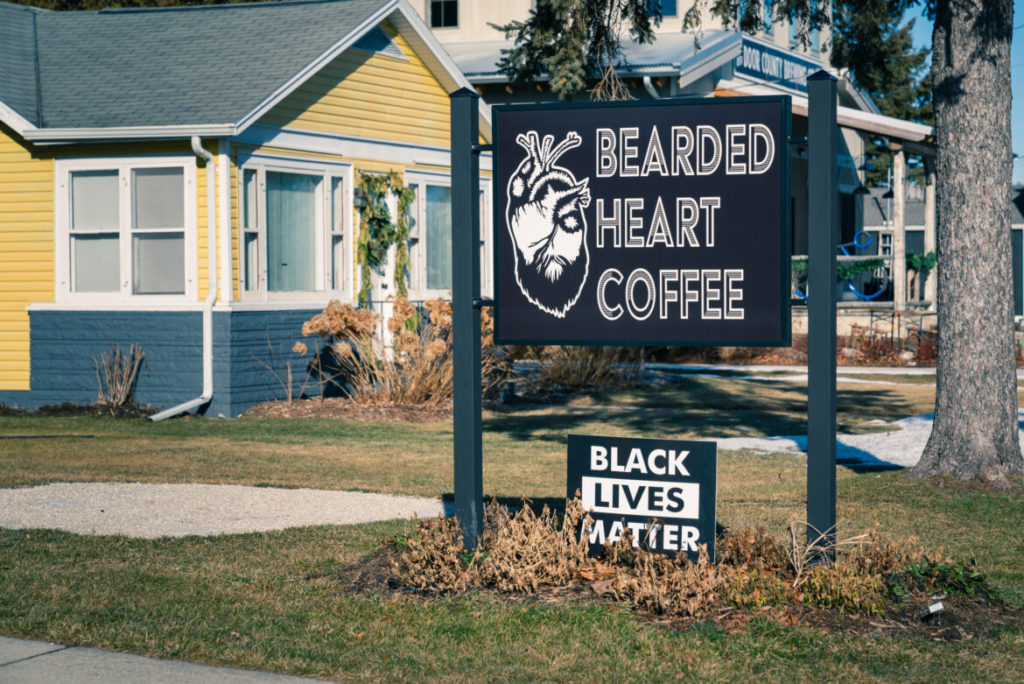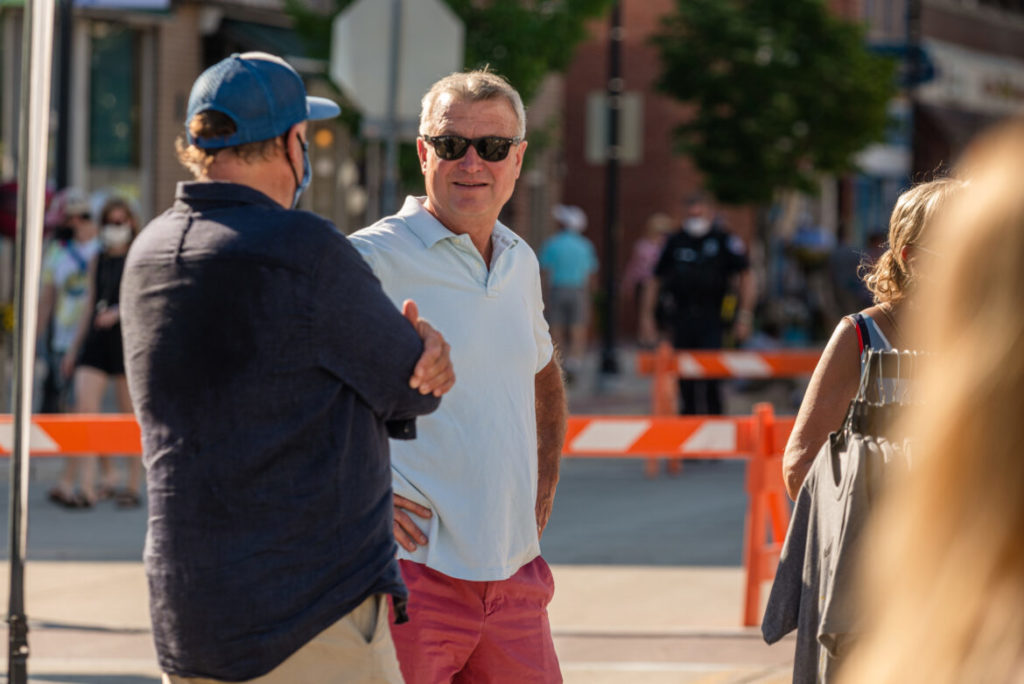
This summer, amid the country’s roiling pandemic and racial unrest, Sage Conrad hung signs outside of the café her parents own. The message was simple: “Black Lives Matter.” Conrad, the shop’s general manager, also placed signs at an adjacent boutique she owns in the Door County, Wisconsin, town of Baileys Harbor.
The family typically kept business apolitical, but Conrad felt the moment’s gravity called for the gesture.
“We found it important to vocalize our political views and use our business as a platform to talk about what was going on in the world,” she said.
Most of Conrad’s customers applauded the message of solidarity. But several longtime customers left angry voicemails vowing to never return. Another showed up to shout disapproval, she said.
Such was life in small-town Wisconsin as hyper-partisan rhetoric echoed and the state was poised to play a major role in the 2020 presidential election.
In Door County, one of two counties Joe Biden flipped in its tightest election in at least 40 years, that also meant vandalism at the county Republican Party headquarters and discomfort over another business owner’s “Blue Lives Matter” display.

(Brett Kosmider for Wisconsin Watch)
Wisconsin, which also narrowly went for Biden, has a history of razor-thin statewide election returns, with voters deciding four of the last six presidential elections by fewer than 23,000 votes. Analysts and pollsters say these close contests may become more common as the state electorate inches toward a nearly even party split.
While such division can increase political participation, it can also exacerbate polarization at a time when national politics are fueling partisanship and violent rhetoric.
Those forces boiled over on Jan. 6, when a pro-Donald Trump mob attacked the U.S. Capitol in a futile effort to stop Congress from certifying Biden’s victory. At least one Wisconsin resident was arrested.
“This was the worst it’s ever been,” said Wisconsin Assembly Minority Leader Gordon Hintz, D-Oshkosh. The 13-year veteran of the chamber said he had experienced a year of aggressive rhetoric directed “to me, to my wife, on social media — even from people who I either consider friends or am friendly with.”
A dramatic cool-down appears unlikely in a gerrymandered political system that incentivizes more extreme campaigning, analysts say. It doesn’t help that partisan Wisconsinites increasingly disagree on what is even true, as misinformation about the pandemic and politics spreads widely.
A divided political history
The state is among just five to have elected one Democrat and one Republican to the current U.S. Senate: Democrat Tammy Baldwin and Republican Ron Johnson. Baldwin is considered among the most liberal in the Senate, joining party mates and a few Republicans in calling for Trump’s removal following the Capitol siege. Johnson was among those leading opposition to certifying the election — reversing his position only after the attack.
“That’s just very reflective of Wisconsin,” said state Rep. Joel Kitchens, a Republican who represents Door County and most of the peninsula jutting into Lake Michigan. “Our Democrats tend to be very liberal, and our Republicans tend to be very conservative … Everybody wants us to get along, compromise and all that. But then you look at the leadership on both ends, and it’s just pretty extreme.”
Partisan division has paralyzed Wisconsin’s efforts to tackle its biggest challenges — including a pandemic that has killed more than 5,600 residents and left thousands jobless and dependent on a dysfunctional unemployment system.

(Brett Kosmider)
The GOP-controlled Legislature last year successfully sued to restrict the pandemic powers of Democratic Gov. Tony Evers’ administration, alleging an overreach. That left local governments on their own to adopt public health measures, some of which sparked partisan pushback. Evers and top Republican lawmakers did not speak for six months of 2020, a stretch when Wisconsin’s full-time Legislature was the least active in the country.
Kitchens said he wouldn’t be surprised if the Legislature in 2021 sends Evers a record low number of bills.
Wisconsin wasn’t always so narrowly split. The state’s first 80 years of elections mostly returned Republican winners, while some local races departed from the trend. Milwaukee, a Socialist stronghold in the early 1900s, elected the nation’s first Socialist congressman and a string of three Socialist mayors.
Wisconsin’s presidential vote has oscillated since 1952, with Democrats clinching 10 races and Republicans eight. With the exception of Barack Obama’s wins in 2008 and 2012, less than 1 percentage point decided the last several elections.
Shifting electorate
“We did see an evolution over the last nine years that took us from very competitive but a slight Democratic edge to this basically dead, even party split,” said Charles Franklin, director of the Marquette Law School Poll. “And almost all of that shift came from white men without a college degree.”
In 2012, these voters identified 4 percentage points more Republican than Democratic. Now they identify 24 percentage points more Republican than Democratic, Franklin said.
This shift predated Trump, and Franklin sees the declining influence of Wisconsin’s labor unions — accelerated by Republican-passed laws — as playing a role, alongside a GOP strategy to tailor messaging to working voters.
The shifting dynamics surface regionally, Franklin said. Southeast Wisconsin is less of a Republican stronghold than it once was, while northern and western Wisconsin are increasingly Republican. This divide is tougher to parse out, Franklin said, but is likely linked to differences in education levels and other socioeconomic factors.
Door County, home to Conrad’s café, is split differently, Kitchens said. Northern communities are voting more Democratic, while southern communities are increasingly Republican.
The shift comes amid a tussle over who represents the “real” Door County: the highly-educated retirees, artists and environmental enthusiasts in the north or the farm families in the south?
“Sometimes the different sides don’t understand each other very well,” Kitchens said.
He also represents Door County’s southern neighbor, Kewaunee County, which in recent years shifted from Democratic to Republican.
“I think my district is a pretty good microcosm of what happened around the state — where the divisions got so much starker,” Kitchens said. “Trump’s personality played into it so strongly. Certainly the rural and urban and suburban divide deepened.”
Redistricting drives division
Partisan gerrymandering — in which lawmakers pick their voters during once-per-decade redistricting — has deepened divisions. In redrawing the state’s electoral maps in 2011, the Republican-controlled Legislature and Republican Gov. Scott Walker created a system that could lock 60% of legislative seats for their party with just 48% of the statewide vote, according to an analysis by the Brennan Center for Justice. Republicans in 2018 won a minority of the statewide vote but a majority of seats.
Sachin Chheda, director of the Milwaukee-based Fair Elections Project — a nonpartisan group promoting independent redistricting — said gerrymandering deepens divisions in two ways: It makes lawmakers more responsive to their parties than their constituents, and it encourages more extreme positions to secure primaries that typically draw more partisan voters.
Wisconsin is gearing up for a fresh redistricting fight following the 2020 census. Evers has assembled a nine-member commission to collect input from public hearings and present the Legislature with “nonpartisan” maps. But GOP leaders will likely send their own maps to Evers, which he could veto, leaving judges to decide.
A 2019 Marquette Law poll found that 72% of Wisconsin voters want a nonpartisan committee to draw new lines. At least 17 states have adopted practices aiming to limit partisan gerrymandering, but lawmakers in the majority have no incentive to overhaul a system designed to keep them in office.
‘Fusion of forces’ drive trend
Lawmakers and policy experts are pondering a “chicken or the egg” question surrounding hyper-partisanship: Are voters echoing politicians or vice versa?
“It’s not an absolute one side — one way or the other,” Kitchens said, “But I think overall, when the people are this polarized, we get pushed by them to take our positions.”
Said Hintz, the Democratic leader: “It’s probably a fusion of forces, including social media, including the nationalization of politics.”
Hintz knows that connecting with Republican constituents remains inherently difficult for members of his party. When speaking to someone who believes Trump’s repeatedly debunked claims that Democrats stole the election, for example, Hintz must acknowledge that they understand facts differently.
Hintz subscribes to the route U.S. Sen. Mitt Romney, R-Utah, laid out following the Capitol violence: “The best way we can show respect for the voters who were upset is by telling them the truth.”
But insistence that the election was stolen has become more a “religious fervor rather than anything that can be moved by evidence,” said Charlie Sykes, a former conservative radio host in Milwaukee who has spent years criticizing Republicans who embrace “Trumpism.”
Some Wisconsin Republicans have faced fierce backlash after speaking out against Trump’s false claims. Fond du Lac County GOP Chairman Rohn Bishop, who called efforts to invalidate the election results disenfranchisement, said the response from Trump supporters “almost broke me.”
And several members of Wisconsin’s congressional delegation, including Republican U.S. Reps. Tom Tiffany and Scott Fitzgerald, amplified the false message that “irregularities and violations” had tainted the election — the same one that elevated both of them to Congress. Neither responded to interview requests.
Trump-style rhetoric has spread statewide. In St. Croix County, the local Republican Party called for “removing leftist tyrants from all local and County positions” in a web posting that also warned: “If you want peace, prepare for war.” The party initially left the message online after the Jan. 6 attack, but disabled the website and ousted the chairman, following media scrutiny.
Another Republican congressman, Rep. Mike Gallagher of Green Bay, pointed out the risk of such rhetoric in a video he posted after barricading himself in his Capitol office.
“This is the cost of countenancing an effort, by Congress, to overturn the election and telling thousands of people that there is a legitimate shot of overturning the election … even though you know that is not true,” he said.
Sykes fears that the disinformation and vitriol of 2020 may forecast what is to come.
“We don’t know where it’s going … whether or not this is the last spasm of something, or whether it’s prologue,” he said.
‘Easy to burn a bridge’
The state’s thin party split carries some advantages for a functioning democracy, including driving voter engagement. Wisconsin saw the country’s fifth highest turnout in the 2020 presidential election, and the second highest in state history.
That means statewide politicians — governors and U.S. senators, for instance — must still respond to voters, even if gerrymandering means less competition and less accountability for legislative seats, Chheda said.
“Candidates, campaigns and issues do still matter,” added Franklin.
Hintz said he aims to mend the divisions, but he can’t ignore the recent threats to democracy.
“My optimistic side says there’s still so much about Wisconsin that we all share and that we all value … there’s a lot of diversity and differences in different parts of the state,” he said. “And maybe it’s not as strong as it once was. But there’s a fabric.”
That fabric remains intact in Door County, even following the tumultuous year, said Britton Unkefer, who owns Wild Tomato Wood-Fired Pizza and Grille, which has two locations in the county’s north.

(Brett Kosmider for Wisconsin Watch)
Unkefer, like Conrad, displayed a political message at his business for the first time this summer. He hung a “Blue Lives Matter” sign, a nod to his brother-in-law who is a police officer.
A former employee took offense, prompting what Unkefer described as a civil conversation. He ultimately removed the sign.
Unkefer said many local issues are of greater concern to Door County residents — ones that often do not fall neatly along party lines. They include a lack of affordable housing for people who work in the tourism industry and development and zoning questions.
Political conversations remain tricky, said Conrad, the boutique owner. Some neighbors are careful not to upset each other – for personal and business reasons.
“It’s just really easy to burn a bridge,” she said. “It can be pretty bad news, in a place this small.”
But Unkefer said that closeness creates accountability and can prompt civil conversation before an issue becomes too contentious.
“At the end of the day, we all see each other,” he said. “We all work with each other and our kids go to school together.”



























